Wrapping up the year with all that you’ve helped accomplish for nature
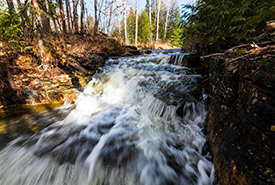
Waterfall, Vidal Bay, ON (Photo by Esme Batten/NCC staff)
It’s been a year of amazing conservation outcomes for the Nature Conservancy of Canada (NCC). Our achievements in 2021, from coast to coast, reaffirmed our belief that we are all interconnected. Without nature, there is no path to a sustainable future. That’s why conservation matters.
Thanks to your support, and the support of partners and volunteers, many Nature Conservancy of Canada (NCC) projects made tremendous progress over the past year. Together with many other supporters, your involvement has made a meaningful impact from coast to coast. Read about some of the highlights below:
Safer passage for bears
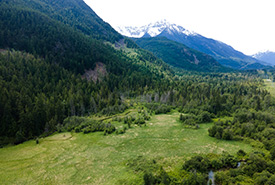
Gates Creek (Photo by Fernando Lessa)
In June, NCC and the Fish & Wildlife Compensation Program joined forces to conserve Gates Creek Conservation Area near D’Arcy, BC. Located in the territory of the St'at'imc people, adjacent to the N’Quatqua First Nation, these 111 hectares of forest and wetland provide habitat for many plants and animals, including 14 Species at Risk Act-listed species. Crucially, Gates Creek offers habitat connectivity for two at-risk populations of grizzly bears, which are increasingly threatened by habitat loss and fragmentation.
Learn more about Gates Creek >
Restorative collaborations
In partnership with NCC, Wild + Pine, an Edmonton-based climate action company, planted 55,000 stems of a variety of species. These stems were selected to replicate a naturally occurring ecosystem in the Aspen Parkland region. This tree planting project is part of a plan to reforest 25 hectares of important habitat in the Red Deer River natural area. Restoring habitat here will benefit the wildlife that use the area. The property will continue to be monitored as it grows into a reclaimed, biodiverse habitat that will benefit wildlife for years to come.
Sprucing up the holidays
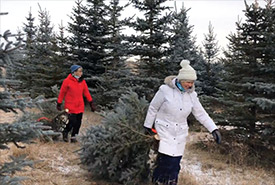
Volunteers harvesting Colorado blue spruce trees near Red Deer. December 5, 2021 (Photo by NCC)
On the flip side, sometimes restoring and stewarding an area requires removing certain species. Over the December 4–5 weekend, NCC hosted its annual Christmas trees for conservation event. In an effort to naturalize a former tree farm, 31 volunteers removed 56 non-native Colorado blue spruce trees from an NCC property near Red Deer. Harvested trees were the made available to the community by donation. More than $800 was raised for conservation during the community outreach event at the Kerry Wood Nature Centre.
Doubling impact
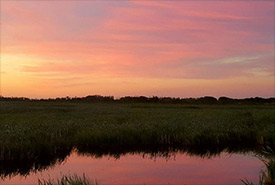
Sunset over Douglas Marsh, MB (Photo by NCC)
This summer, thanks to the generosity of the Central Assiniboine Watershed District and other donors, NCC doubled its Douglas Marsh protected area in the Assiniboine Delta. Located near Brandon, Manitoba, this expansive wetland complex and surrounding upland area helps with water regulation and protects neighbouring areas from spring melts and summer droughts.
Along with being an Important Bird Area that bustles with biodiversity, Douglas Marsh is critical for sustaining and protecting the water quality of the aquifer that flows through the land toward the Assiniboine River.
Learn more about Douglas Marsh >
Protecting a prairie hot spot for shorebirds
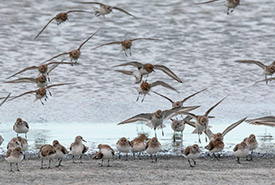
Sanderlings at Mackie Ranch, SK (Photo by Jason Bantle)
This year, a large section of native grassland and part of an important shoreline a few kilometres off the Trans-Canada Highway, between Moose Jaw and Swift Current, was protected. Mackie Ranch is located along the eastern shoreline of Chaplin Lake, the second largest saline lake in Canada. Over half of the world’s population of sanderlings stop to rest and feed here during their spring migration. Many other migratory shorebirds also visit the lake, such as semipalmated sandpipers, Baird’s sandpipers, red knots and piping plovers. This property 646-hectare property, with its temperate grasslands and wetlands, is home to many plants and animals, including Saskatchewan’s provincial bird: sharp-tailed grouse. The area also provides many nature-based solutions, such as filtering water, buffering floods and droughts, sequestering carbon and more. Now that it is conserved, it will continue to be a viable ecosystem for years to come.
Learn more about Mackie Ranch>
Conserving large landscapes
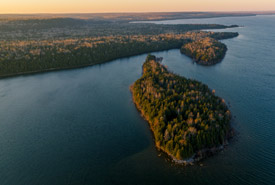
Vidal Bay, Manitoulin Island, ON (Photo by Striking Balance)
The world is facing the twin crises of rapid biodiversity loss and climate change. The size of the challenge demands that we work at an unprecedented pace and scale to conserve the natural areas that are our life support systems.
Vidal Bay Forests and Shoreline is one of the largest-ever single-property acquisitions in Ontario. Covering 7,608 hectares, the Vidal Bay Forests and Shoreline property protects almost 20 kilometres of shoreline on Manitoulin Island, on the north channel of Lake Huron. This is an excellent example of the scale of work needed to tackle climate change and the biodiversity crisis. Vidal Bay provides an uninterrupted wildlife corridor for species like American black bear and gray wolf to survive and thrive across western Manitoulin Island.
Check out other year-end successes in Ontario >
Helping to bring back spiny softshell turtles
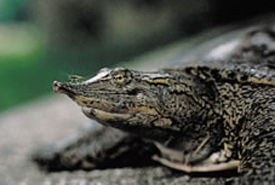
Spiny softshell turtle (Photo by NCC)
In Quebec, the spiny softshell turtle could once be seen in the Ottawa, St. Lawrence and Richelieu rivers. Today, in Quebec, it is only found at Lake Champlain. The spiny softshell turtle is designated as endangered in Canada. Invasive plants, shoreline development, poaching and water pollution all threaten this species.
This year, NCC restored a pond to provide critical habitat for spiny softshell turtles and many other native species. Thanks to your support, the spiny softshell turtle is getting the help it needs to begin building back its population.
Expanding and connecting nature
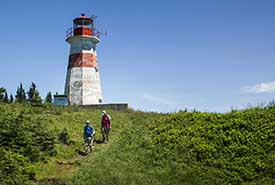
Musquash Head Ligthouse (photo by Denis Duquette)
Over 300 donors helped conserve 111 additional hectares in the Musquash Estuary conservation area, on New Brunswick. Conservation Volunteers also helped improve public access to the site by connecting three existing trails. One of the sites conserved includes almost 40 hectares at Musquash Head. Together with partners, NCC raised funds to restore a historic lighthouse built here in the 1950s.
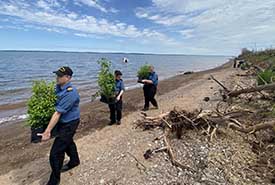
Volunteers from the Royal Canadian Navy planting trees, Governors Island, PEI (Photo by NCC)
In June, the Royal Canadian Navy helped plant 100 spruce and birch trees over a half hectare on Governors Island, PEI. This effort was supported by the Government of Canada’s 2 Billion Trees Program and will help boost forest regeneration for the benefit of double-crested cormorants and great blue herons. NCC is excited to support these large families of colonial nesting birds for years to come!
Read more about Governor’s Island and the planting here >
Conserving old-growth Wabanaki (Acadian) forests
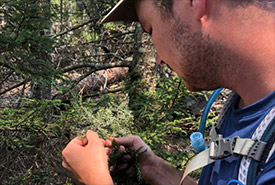
Monitoring for hemlock woolly adelgid (Photo by NCC)
Old-growth Wabanaki (Acadian) forest, of which very little of this original habitat remains in the Maritimes, as well as lake shoreline and freshwater wetlands are receiving some tender loving care thanks to the conservation of 119 hectares in southwest Nova Scotia. As a part of ongoing stewardship work, NCC staff will be detecting and monitoring the presence of a non-native, invasive species called hemlock woolly adelgid that attacks and kills hemlock trees.
Caring for and encouraging diversity
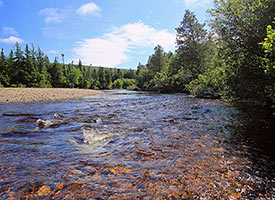
Barachois Brook Nature Reserve, NL (Photo by Aiden Mahoney)
NCC is working with the Qalipu First Nation’s Department of Environment and Natural Resources to create more open spaces in a densely cultivated forest on Barachois Brook. The area currently has exceptionally low species diversity because of dense spruce trees that block the light required for plant growth. Opening areas of this forest will allow other native species, such as balsam fir, birch and other forest floor species, to grow and thrive.
Read more about the impact that you and other supporters have had in the Atlantic Region >
Several of these projects were made possible with support from the Natural Heritage Conservation Program, a unique public-private partnership that mobilizes Canadians to conserve and care for the places they cherish. Thanks to program partners like NCC, the NHCP continued its strong momentum this year. Since the partnership’s inception in 2007 more than 600,000 hectares of land and freshwater has been conserved across Canada with help from the program.
In the year ahead, we believe we are in a good position to make significant progress on five corporate priorities:
- Align with our bold strategic plan;
- Embrace inclusion and collaboration. This includes continuing to work with Indigenous Peoples to achieve the conservation of lands and waters;
- Build more support of our work through increased fundraising and awareness;
- Leverage innovation and technology to leverage our work; and
- Continue to deliver on our conservation goals across the country.
Your continuous support is what inspires and fuels the Nature Conservancy of Canada in making conservation work happen. With NCC, you are turning intention into action. Thank you for making the last year a success.
For more success stories, read our 2020-2021 Annual Report here >




